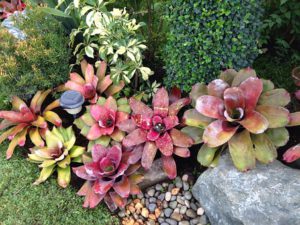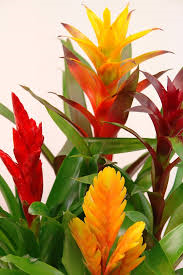Bromeliad Grow Guide

Bromeliads are some of my favorite plant species that I have worked with for more than 25 years, these garden beauties come in so many shapes, sizes, and colors, in fact, there are estimated to be 2,877 species of bromeliads making these plants one of the largest in the plant kingdom. Besides their beauty, I also love bromeliads because they’re low maintenance so for anyone who wants plants but doesn’t have much time to spend in their garden then bromeliads are the ideal plants for you.
Bromeliads are a family of plants (Bromeliaceae, the pineapple family), these plant species are native to North and South America, history records that ” the Europeans first found out about bromeliads on Columbus’ second trip to the New World in 1493, where pineapples were being cultivated by the Carib tribe in the West Indies”.
Bromeliads have a rich history and have been around for quite some time, although bromeliads are popular for being mostly growing indoors we will be taking a closer look at how to care for and grow bromeliads in our landscapes and gardens.
How to Care for Bromeliads Outdoors
- The natural habitat for bromeliads are tropical rainforests, mountains, and even desert areas because these plant species thrives best in humid conditions and on shady forest floors Its best to provide these conditions for bromeliads where they can get full sun but are provided with some evening shade as well
- The leaves of some bromeliad species however tend to suffer burn when exposed to too much sun so before installing bromeliads get to know which species stand up well when directly expose to the sun
- The soil of bromeliads should be a soil that drains well, loose soil will encourage proper drainage because bromeliads don’t like wet feet
- When watering bromeliads allow the soil to be moist, not waterlogged which will lead to root rot because bromeliads hate wet feet, some persons also add water to the center cup. The ideal type of water to add to the center cup is rainwater, don’t use hard or tap water which can cause the center cup area to begin to rot. Also if water is in the central cup don’t let it remain to stagnate for more than a week which will encourage or invite fungus that will lead to crown rot. Symptoms of crown rot are the leaves turning brown followed by a foul odor. Once the soil is well moistened you should not have to water it again until two weeks time, during the summer months or extreme heat however the soil should be checked about every three to four days
- When growing bromeliads outdoors don’t need that much fertilizer, a weak balance liquid or water-soluble fertilizer once a month can be used during the spring and summer months.
Bromeliad Pest Identification and Control

Although the pests issues of bromeliads are small keep a watch out for these pests and take quick action to bring control.
- Scales are tiny insects that resemble lumps or bumps, they seem to be motionless but the damage is being done, they cause injury by sucking the plant’s fluids, with a clean dump cloth proceed to wipe the scale infestation. Once this is done apply insecticidal soap or neem oil once a week until the reminder of scales is eliminated, before applying insecticides read and follow the manufactures directions for the best results
- Spider mites are tiny insects that are barely visible to the human eyes, they may appear as yellow or brown spots on the plant’s leaves. Spider mites dose the seem damage as scale insects. Treat the same way as when treating scales
- Mealybugs are tiny white fuzzy insects that do the same damage as scales and spider mites, treat the seem as you would scales and spider mites
Bromeliad Disease Identification and Control
- Rust Disease symptoms show up as rusted-colored, liquid-filled blisters on the leaves’ undersides, if control measures are not taken immediately rust will move through the leaves and eventually appear as light yellow or white spots when seen from the top position. Infected plant parts should be removed and discarded, spray the plant with a rust control product containing fungicide every seven days and repeat as recommended according to the manufacturer’s label
- Pythium attacks the plant root system causing rot, signs of this disease include wilting, discoloring that’s often a bland grayish-green color, and dark mushy roots. Control measures include monitoring the amount of water bromeliads are receiving (don’t overwater). Remove disease parts and discard off.
- Root and Crown Rot appear as soggy and brown crown that produce a foul odor from the center along with the leaves being removed easily with a gentle pull. Control this disease by removing as much of the infected plant tissues as possible back to white or healthy tissue. Apply a fungicide according to the manufacturer’s directions and decrease the amount of water. Also, ensure that your plant is getting proper air circulation.
- Helminthosporium leaf spot symptoms of this disease first appear as yellow and blister spots, the spots will eventually enlarge and become sunken and brown, and a yellow border may appear around the outer edge of the spot. In extreme cases, the leaves will begin to collapse and hang from the bromeliad, reduce the amount of water that bromeliads are receiving, remove disease parts, and apply bonide Multi-Purpose fungicide according to the manufacturer’s directions.
Dividing Bromeliads
What I love about bromeliads is the pups they produce or the babies, these pups or offsets can be found growing from the plant’s base once the parent plant finish flowering. These pups can be separated from the parent plant with a sharp clean hand pruner, the ideal time to separate the pup from the parent plant is when the pup reaches one-third of the parent plant.
The final word on how to care for bromeliads outdoors
Growing bromeliads outdoors is that simple, these garden beauties are easy to care for and will give your garden that color pop. I believe this guide will help you to grow and care for bromeliads the right way. Join the many homeowners and growers that are having much success with these plant species, I have worked with so many types of bromeliads both outdoors and indoors and have seen the beauty they bring in either of these settings. Go ahead and give them a try and see for yourself as they go to work for you by introducing that tropical look that’s so amazing.
About the author
Norman loves being in the garden, both at home and for his job....
he is 'Natures Little helper' being outdoors, growing his vegetables and flowers from an early age.
Now having spent over 22 years in the profession he want to give some of his knowledge to others...
his vast array of hints and tips you will find scattered over this site will help you no end growing plants in your garden.
